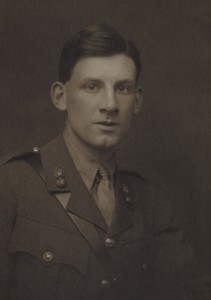‘Swear by the slain of the War that you’ll never forget’: Siegfried Sassoon’s First World War Poems in Context
The First World War was one of the defining conflicts of European history. On 4 August 1914, the date when Britain entered the War, a 27 year old poet and sportsman from Kent named Siegfried Sassoon (1886–1967) voluntarily enlisted. Sassoon’s direct experience of a catastrophic War which lasted four long years and saw an estimated 37 million soldier and civilian casualties would establish his reputation as one of the finest poets of the Great War and as one of its most outspoken critics. One hundred years since the War began, the anger, compassion and caustic realism of Sassoon’s poems still resonate today.
‘Swear by the slain of the War that you’ll never forget’,[1] a new exhibition in the University Library’s Entrance Hall, charts the evolution of Sassoon’s poetry and his changing attitude towards the War which influenced him so profoundly. The exhibition presents five of Sassoon’s best-regarded poems, paired with and contextualised by contemporary books and sketches from the Library’s collection.
Serving with the Royal Welch Fusiliers, Sassoon was initially an ambitious and enthusiastic soldier. Included in the exhibition is an example of his early war poetry, ‘Absolution’ (1915), reflecting his initial belief in the War as one of defence and liberation, and his desire to show that ‘poets can fight as well as anyone else’.[2] It is displayed alongside an explanatory book on the War for children, dated to 1914, expressing the prevailing sentiment that Britain was entering a noble War.
The second poem exhibited, ‘The Kiss’ (April 1916), was written just a few months before Sassoon was awarded the Military Cross for recovering a wounded corporal under heavy fire. A veritable celebration of the bayonet and the bullet (‘Brother lead and sister steel’), the poem was inspired by a lecture on ‘The Spirit of the Bayonet’ by Major Ronald Campbell, one of the supreme proponents of bayonet fighting on the Western Front. Sassoon’s notes from the lecture are also displayed, along with an instructional handbook for soldiers on how to use the bayonet, sword and lance. The notes abound with blood-thirsty sentiments and chilling phrases such as ‘only one good sort of German, – a dead one’.[3]
As the War progressed, Sassoon’s attitude towards it began to change fundamentally. Already by 1916 he had suffered the loss of his brother Hamo Watts Sassoon, who died at Gallipoli in October 1915, and of his close friend David Thomas, who died the following March. Between July and November 1916 the Somme Offensive left over one million men dead or wounded, with almost 20,000 British soldiers killed on the first day alone. Sassoon’s direct experience of the horrors of trench warfare and growing anger at the continued suffering of his men led to a change in the tone of his poems, which now began to incorporate soldierly slang and sardonic and bitter twists. These later war poems were deliberately designed to disturb the complacency of those back home in Britain, and questioned the authority of the Establishment which was sending so many young men to their deaths.
The third Sassoon poem on display, ‘They’ (October 1916), is a prime example. It was written as a direct attack on the role of the Church in fostering War propaganda. The poem is presented alongside a selection of religious pocket books for soldiers, with titles such as War and Christianity and Conscription in the Bible. While these were designed on the one hand to provide comfort for servicemen, they also highlight the Church’s direct support for the War effort. The examples on display include contributions by the Archbishop of Canterbury and other key figures among the clergy.
Sassoon’s poem ‘The General’ is similar in tone to ‘They’, and features a glib general who incompetently sends hordes of young men to the slaughter. Sassoon wrote the poem in April 1917 while recuperating from a shoulder wound obtained at the Battle of Arras. It is displayed alongside a contemporary sketch from John Robert (‘Jack’) Monsell, an Irish writer and children’s book illustrator who served with the 56th London Division. Like Sassoon’s soldiers who ‘slogged up to Arras with rifle and pack’, the exhausted soldiers in Monsell’s drawing carry heavy packs as they trudge through a desolate landscape.
Soon after writing ‘The General’, Sassoon drafted his ‘Soldier’s Declaration’, his famous protest statement against the War. It outlined his belief that the War had become one of aggression and conquest, and was being ‘deliberately prolonged by those who have the power to end it’. While his protest achieved national attention, Sassoon was not court-martialled but diagnosed with ‘shell shock’ and sent to Craiglockhart War Hospital near Edinburgh. It was there that he wrote the final poem on display, ‘Does it Matter?’ (1917), a poem which deals with the lasting effects of the War on soldiers left disfigured, blinded, or mentally affected by their experiences. It is exhibited alongside a contemporary gift-book which was compiled to raise funds for blinded soldiers and sailors convalescing at St Dunstan’s Hospital, London.
A letter from Sassoon at Craiglockhart is also displayed, in which he mentions that Dr [William H.R.] Rivers was enquiring into his ‘mental aberrations’.[4] It was under the treatment of Rivers, a Cambridge anthropologist and physician, that Sassoon was persuaded to ‘do right by his men’ and return to the Front. He served in Palestine and France before a head wound in July 1918 ended his direct involvement with the War.
The exhibition will run in the Entrance Hall until Saturday 16th August.

